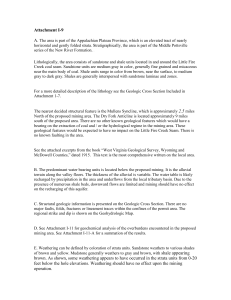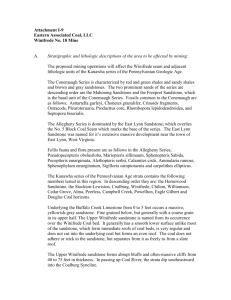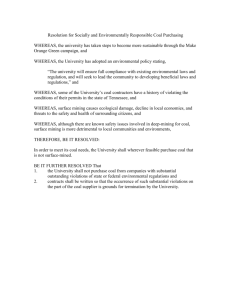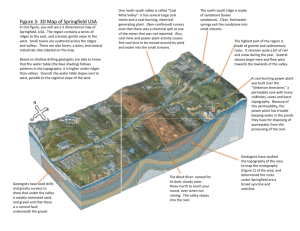Attachment I
advertisement
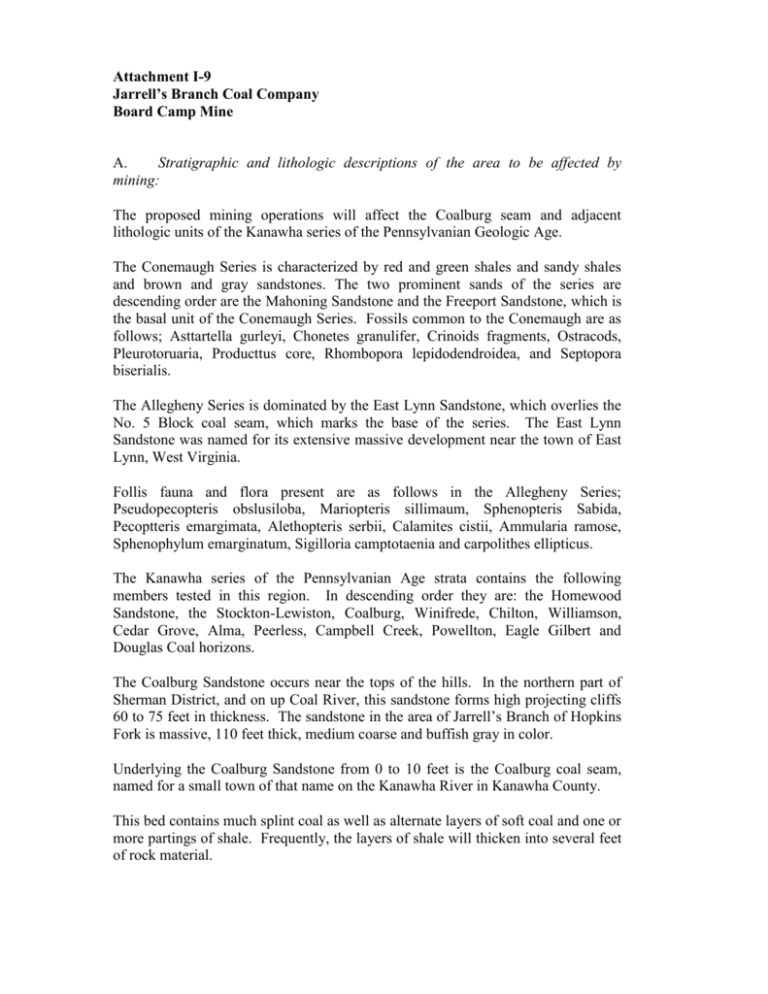
Attachment I-9 Jarrell’s Branch Coal Company Board Camp Mine A. Stratigraphic and lithologic descriptions of the area to be affected by mining: The proposed mining operations will affect the Coalburg seam and adjacent lithologic units of the Kanawha series of the Pennsylvanian Geologic Age. The Conemaugh Series is characterized by red and green shales and sandy shales and brown and gray sandstones. The two prominent sands of the series are descending order are the Mahoning Sandstone and the Freeport Sandstone, which is the basal unit of the Conemaugh Series. Fossils common to the Conemaugh are as follows; Asttartella gurleyi, Chonetes granulifer, Crinoids fragments, Ostracods, Pleurotoruaria, Producttus core, Rhombopora lepidodendroidea, and Septopora biserialis. The Allegheny Series is dominated by the East Lynn Sandstone, which overlies the No. 5 Block coal seam, which marks the base of the series. The East Lynn Sandstone was named for its extensive massive development near the town of East Lynn, West Virginia. Follis fauna and flora present are as follows in the Allegheny Series; Pseudopecopteris obslusiloba, Mariopteris sillimaum, Sphenopteris Sabida, Pecoptteris emargimata, Alethopteris serbii, Calamites cistii, Ammularia ramose, Sphenophylum emarginatum, Sigilloria camptotaenia and carpolithes ellipticus. The Kanawha series of the Pennsylvanian Age strata contains the following members tested in this region. In descending order they are: the Homewood Sandstone, the Stockton-Lewiston, Coalburg, Winifrede, Chilton, Williamson, Cedar Grove, Alma, Peerless, Campbell Creek, Powellton, Eagle Gilbert and Douglas Coal horizons. The Coalburg Sandstone occurs near the tops of the hills. In the northern part of Sherman District, and on up Coal River, this sandstone forms high projecting cliffs 60 to 75 feet in thickness. The sandstone in the area of Jarrell’s Branch of Hopkins Fork is massive, 110 feet thick, medium coarse and buffish gray in color. Underlying the Coalburg Sandstone from 0 to 10 feet is the Coalburg coal seam, named for a small town of that name on the Kanawha River in Kanawha County. This bed contains much splint coal as well as alternate layers of soft coal and one or more partings of shale. Frequently, the layers of shale will thicken into several feet of rock material. Attachment I-9 continued Jarrell’s Branch Coal Company Board Camp Mine From 0 to 20 feet under the Coalburg Coal, and separated from the same by layers of impure fire clay and sandy shales, there often occurs a thin bed of coal that has been named the Lower Coalburg Coal from its proximity to the Coalburg seam, being a split from the latter. Underneath the Little Coalburg Coal, there occurs another sandstone that has been named the Lower Coalburg Sandstone. This bed is from 20 to 40 feet in thickness and forms rugged cliffs. It is medium coarse grained, buffish-gray and very hard. B. Hydrogeologic seeting including the areal and vertical distribution of all aquifers; Seasonal differences in head; the name(s) of the stratum (or strata) in which the water is found; and the availability, movement, quality, and quantity of ground water flow in all Aquifer units: According to a survey of local water wells, and the Hydrologic Data for the Coal River Basin, West Virginia most wells are set into either the soil mass (fully cased or dug wells), or into the upper Kanawha Formation which is over 400 feet below the mine area. The only known exception is the Prenter Water Supply Well, which is a former gas well. The well was drilled to a total depth of 2200 feet and extends into the Pocahontas Formation. The static water level is artesian flow, if not pumped. The pump is set at 126 feet from the surface. The depth of casing is unknown. Known sandstone units that are penetrated are the Lower Winfrede, Upper Chilton. Dug wells within the area extend 15 to 30 feet below the surface, and according to the driller’s log for Boone County in the Hydrologic Data survey 19 feet of surficial material were encountered. Depth to water levels range from 0 to 10 feet below the surface which likely means that the water source is being derived from the soil mass and not the Kanawha Formation. Water fluctuations within the soil mass can vary by 4 feet from the wet seasons (March, April) to the dry seasons (September, October). The greatest amounts of surficial materials will most likely occur along the river and stream valleys with water movement flowing toward the streams and rivers. C. Structural geology of the coal seam and strata to be affected by mining both in the Permit and adjacent areas, including faults, folds, fracture and lineament traces, and Regional and site specific strike and dip; A core description for drill holes are listed in Attachment I-10, no faults, fold, fractures and lineament traces have been identified during exploration. See Proposal/ Drainage Map for strike and dip. Also see Attachment I-9.C, Lansat Linear Features of West Virginia. Attachment I-9 continued Jarrell’s Branch Coal Company Board Camp Mine D. Geochemical character of all strata and coal to be disturbed by mining and the potential of this strata for generating acid, alkaline, or iron-laden drainage; Presented as Attachment I-10 are the geologic logs for the core holes used for this part of the permit application. Location and elevation information was presented in Attachment I-8. Sulfur forms were presented in Attachment I-1. Acid/Base accounting information is provided as Attachment I-11. The Coalburg seam has been extensively mined in this area for many years, with the discharges falling well within the guidelines of the Rules and Regulations. As outlined in Paragraph H of this attachment, no discharge is anticipated from this mining operation. Should a discharge occur it should require no chemical or physical (sediment) treatment prior to discharge, based upon present and past water qualities on adjacent mining operations in the same seam, and the results of acid/base accounting of the overburden to be disturbed. As presented on the Acid Base Accounting information included in Attachment I-11, Coreholes B-379C, B-380C, B-381C and B-382C were analyzed for both ABA and Selenium. Also any strata showing high selenium values had the lecheate test performed and all strata showed <.50 mg/l. The lecheate results are reported on the analyses sheet as Column Selenium. As shown on the Acid Base Accounting information included in attachment I-11, the roof material of the Coalburg Coal Seam has a total sulfur content of 0.11, an average paste pH of 7.77 and an excess CaCO3. Total Selenium for borehole B-379C, B-380C, B-381C and B-382C is <0.5 ug/l with TCLP/Column Selenium being <0.5mg/L Most strata shown for the ABA analysis to be greater than 5.00 is less than 1.0 foot thick except Corehole B-380C which shows a 1.02 foot shale unit located directly below the Coalburg A seam, with a deficiency of -12.7. This 1.2 feet of shale will be segregated and permanently stored within the swell percentage of the face up spoil. The swell percentage of the face up spoil is to remain in the storage area after mining. This material will be special handled by placing it away from water ways and enveloping it within four feet of non-toxic material. All the ABA and Selenium data as show on Section A-A, Corehole B380C, will be disturbed by the mine face up. Attachment I-9 continued Jarrell’s Branch Coal Company Board Camp Mine E. Depth and degree of weathering of area strata and the effects this weathering has on the Physical and geochemical properties of the overburden proposed for disturbance; No fractured strata were identified by the driller’s log, and weathering was minimal and should have no adverse effects on the extraction of coal and/or the hydrologic regime. F. Effects of fracturing and weathering on the extraction of coal and hydrologic regime; Fracturing and/or weathering is very minimal and should have no adverse effects on the extraction of coal and/or the hydrologic regime. Fractures may increase ground water flow allowing water following the bedding planes to pass to the underlying strata. Fractures that are not associated with pronounced faults product only a small increase in overall porosity of rocks, therefore, the effect should be insignificant. G. Anticipated impacts of all proposed and exiting operations on the geology and hydrology of the area, including impacts resulting form multiple seam mining and subsidence; It is not anticipated that the impact of the proposed operation will have a profound impact on the geology of the area primarily because the area has a limited amount of undermining and overmining. H. For underground mining operations (including auger mining) indicate whether or not there is the potential for gravity discharge(s) and the anticipated quantity and quality of the discharge(s) from each potential discharge site. For non-gravity discharge situations, indicate the potential for seepage along the outcrop barrier and the potential hydraulic head might result in the underground workings. Indicate if the potential discharge will require chemical treatment. The proposed mine in the Coalburg seam, in this area is located near the top of the mountain. The area has also been undermined in the Dorothy seam. The Dorothy seam is approximately 80 feet below the Coalburg seam The Dorothy seam was dry during mining and the portal and punchouts have no history of discharging. However, as the mining plan, has proposed down dip punchouts, for Attachment I-9 continued Jarrell’s Branch Coal Company Board Camp Mine ventilation purposes. Water samples of a mine discharges from the Coalburg seam are included in Attachment J-10 of this application and identified on the Water Sample Map. The quality of this discharge falls within the guideline of the Rules and Regulations. With this gravity discharge no seepage along the outcrop is anticipated.

